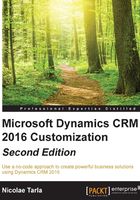
What this book covers
Chapter 1, Getting Started, walks you through an introduction of the platform, and guides you through setting up the trial environment used through the book. No prior knowledge of Dynamics CRM or other skills is assumed. Upon completion of this chapter, the reader will have a free trial sandbox environment valid for 30 days, as well as the client-side configuration for certain scenarios.
Chapter 2, The Dynamics CRM Application Structure, delves into the Dynamics CRM application's structure and describes the standard modules, the elements available for customization, and their relationships to each module, as well as the available options to extend the platform further. In this chapter, you will understand how to manage the existing application structure, how to extend and/or modify the modules, and how to update the navigation accordingly.
Chapter 3, Dynamics CRM Customization, builds on the knowledge gained in the previous chapter, and goes one step further by showing the reader how to work with entities within the existing modules, how to customize and extend these entities, and how to create logical relationships between them. In addition, this chapter will loop back and reference the previous chapter by describing how these new customizations fit within the application modules, and how they can live across various modules. This chapter will also analyze the various document storage options, and the impact of choosing one model versus another.
Chapter 4, Building Better Business Functionality, takes you into the meat of the application by looking at how business affects the behavior of the platform. The reader will look at how to enforce the business rules on the platform, and how to create customizations that will guide and correct the user, thus making sure the platform works with the user. Specific features and enhancements of the platform make it easy for businesses to map their current processes on this platform. Integration with the Microsoft Office suite of products makes Dynamics CRM an even stronger platform, giving users the ability to experience a familiar interface.
Chapter 5, Dynamics CRM – Additional Features, gives you a glimpse inside and outside the platform by diving first into the internal aspects of the platform that have received great enhancements over the last few versions of the product, and then tapping into external data from the market, as well as customers and prospects. You will get an introduction to some of the new features introduced into Dynamics CRM, and you will also get some pointers for the integration with platforms around social and marketing, as well as an overview of analytics options available with the platform and the complementary products.
Chapter 6, Dynamics CRM Administration, guides you through generic administration options available on the platform. While this is by no means an exhaustive guide to the application of administration, this chapter aims to give you enough knowledge about the administration options to provide a base of knowledge. In addition, references to Microsoft documentation will point the readers to available sources to enhance their knowledge.